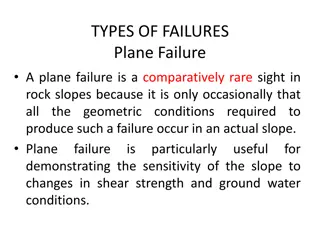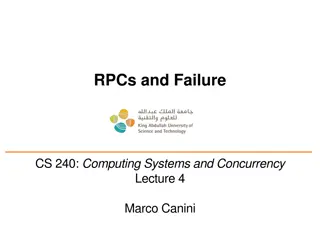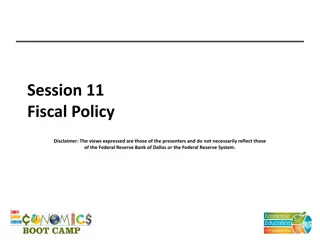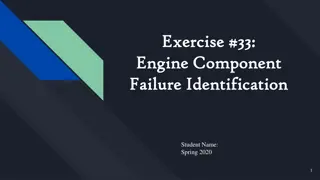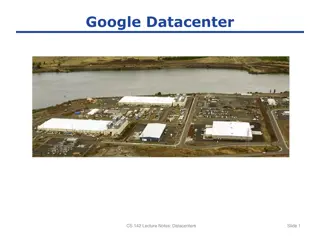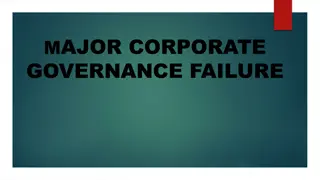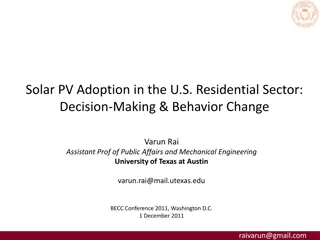
Government Policies and Market Failures Overview
Analyze the impact of government policies on market failures, addressing key issues such as public goods, externalities, competition policy, research and development, training policies, environmental policy, transport policy, and privatization. Understand the role of governments in preventing market failure by establishing rules, promoting competition, regulating natural monopolies, and providing public goods.
Download Presentation

Please find below an Image/Link to download the presentation.
The content on the website is provided AS IS for your information and personal use only. It may not be sold, licensed, or shared on other websites without obtaining consent from the author. If you encounter any issues during the download, it is possible that the publisher has removed the file from their server.
You are allowed to download the files provided on this website for personal or commercial use, subject to the condition that they are used lawfully. All files are the property of their respective owners.
The content on the website is provided AS IS for your information and personal use only. It may not be sold, licensed, or shared on other websites without obtaining consent from the author.
E N D
Presentation Transcript
Government and Business Policies, Market failures 23rd of January
Key issues Market Failure Public Goods Externalities Competition policy; Policies towards research and development; Training policies; Environmental policy; Transport policy; Privatisation.
Market Failure Market Failure A condition that arises when unrestrained operations in the markets yield socially undesirable outcomes What do governments do to prevent market failure? Establishing and Enforcing the Rules of the game Market efficiency depends on people using your resources to maximize your utility. Promoting Competition Preventing firms from colluding. Regulating Natural Monopolies Natural monopolies when one first serves the market at a lower cost than other firms. (and charges a higher price than socially optimal) Providing Public Goods
What is a Public Good A public good is a good that is non-rival and non excludable. Non-Rival Means consumption of the good by one person does not reduce the availability of the good for others. Non Excludable means that no one can effectively be excluded from using the product Examples: Air, Mp3 Songs, Youtube Excludable Non-Excludable Rivalries Private goods Food, Clothing Cars Common Goods Fish Stocks, timber Non-Rivalries Club Goods Cinema, Private parks, satellite television Public goods National TV, Defense Taxes are used to pay for public goods!
Externalities Dealing with Externalities Externality a cost or benefit that falls on a third party and therefore ignored by the two parties to the market transaction. Negative externalities - pollution Positive externalities beautification of the neighborhood Market prices do not reflect externalities Governments use the items below to discourage negative externalities and promote positive positions Taxes Subsidies Regulations
Competition Policy Classical economic theories assume that markets are efficient and that a market system enables competition and innovation Classical and neo-classical economists believed on the limiting roles of Government In practice, markets may not operate efficiently and governments extensively regulate markets to encourage competition
Competitive policy Do you think that market power is always a bad thing ? Producer viewpoint - make supernormal profit, but how large this can be! even with Monopolist can still charge a lower price due to economics of scale more R&D Consumer viewpoint Government concern is that whether the market power goes against the public interest
Competitive policy Three possible targets of competitive policy Monopoly policy the abuse of the existing power of monopolies and oligopolies Merger policy the growth of power through mergers and acquisition Restrictive practices policy oligopolistic collusion
Policies towards Research and Development Technology policy Technology policy involves government initiatives to affect the process and rate of technological change and its rate of adoption Targets of technology policy Invention new ideas, new products Innovation new ideas are implemented in practice Diffusion new technology spreads throughout the economy
Policies towards Research and Development Technological change and market failure R&D free riders property right can protect this monopoly power monopoly may not conduct R&D in the presence of high market power Duplication resources may be wasted in duplicating research risk and uncertainty payoffs from R&D are so uncertain
Research and development by sector Expenditure m 77 820 68 572 28 190 27 436 21 632 20 824 20 184 16 153 14 480 14 001 13 666 10 495 10 055 9 485 9 364 9 077 Intensity % of net sales 14.8 4.1 13.1 11.8 14.0 4.2 3.1 4.0 6.2 3.2 2.4 5.4 4.3 20.9 6.1 1.7 Investment per employee, 53 898 13 845 38 929 31 651 31 090 18 560 14 324 9 711 16 307 12 360 6 751 10 368 6 977 88 476 11 750 4 825 Sector Pharmaceuticals Automobiles and parts Semi-conductors Telecommunications equipment Software Electronic equipment Chemicals Aerospace and defence Leisure goods Computer hardware General industrials Computer services Electrical components and equipment Biotechnology Healthcare, equipment & services Fixed line communications Source: Based on data from 2011 EU Industrial R&D Investment Scorecard, (European Commission)
R&D intensity 6.0 EU 1000 and Non-EU 1000 Japan UK USA Germany 5.5 5.0 4.5 4.0 R&D intensity% 3.5 3.0 2.5 2.0 1.5 1.0 0.5 0.0 2005 2006 2007 2008 2009 2010 Source: Based on data from Eurostat, Science and Technology Database, (European Commission)
Policies towards Research and Development Forms of intervention the patent system public provision R&TD subsidies co-operative R&D diffusion policies other policies
Policies towards Training Training and economic performance labour productivity productivity gap between countries partly depends on differences in skills innovation and change importance of adaptability and skills of the workforce costs of production skills shortages create labour bottlenecks and increase production costs
Policies towards Training Training policy approaches to training policy encouraging workers to stay with their employer subsidies for training industry-wide training programmes by firms publicly provided training partnerships between government and firms
Environmental Policy Pollution could be classified as a negative externality of production and consumption Production marginal social costs (MSC) are greater than the marginal private cost to the polluter No charge on the producer for use of air and rivers means that environment is a free good encourage overuse This is role of the Governments to ensure minimum environmental quality
Global CO2 emissions, 1900 to 2010 9000 8000 Oil and gas flaring Cement production Solid fuels Liquid fuels Gas Million metric tons of carbon 7000 6000 5000 4000 3000 2000 1000 0 1900 1950 2000 Source: Carbon Dioxide Information Analysis Centre (2012) http://cdiac.ornl.gov/
Environmental Policy Environmental policy options market-based policy: market-based policies attempt to internalise the cost of externality, and ensure that the polluter pays. Indirect taxes on specific types of polluting activity , such as green tax Tax should be equal to marginal external cost to achieve a socially efficient output
Environmental Policy Problems with using taxes difficulty in identifying socially efficient tax rate problems with demand inelasticity redistributive effects problems with international trade effects on employment uses of green taxes in various countries
Environmental Policy Non-market-based policy: Command and- control (CAC) systems: The use of laws or regulations backed up by inspections and penalties for non-compliance approaches to devising CAC systems technology-based standards based on best available pollution control strategy ambient-based standards - based on minimum standards for the environment social-impact standards focuses on the effects on people (e.g., health or happiness)
Transport Policy Traffic congestion is a challenge for all nations adds costs and stress of modern living The allocation of road space demand for road space a derived demand to get to the destination determinants of demand price, maintenance cost, income etc. the price and income elasticities of demand Price of substitutes/complements Complementary service, e.g., parking
Increase in car ownership in various European countries 650 Belgium Sweden France Spain UK Italy 600 Cars per thousand population 550 500 450 400 350 300 250 200 1980 1985 1990 1995 2000 2005 2010 Source: based on data in Energy and Transport in Figures (EC, 2009)
Transport Policy Policy 1: direct provision the road solution - more roads public transport Policy 2: regulation and legislation restricting car access bus and cycle lanes no entry to side streets pedestrian-only areas parking restrictions
Transport Policy Policy 3: changing market signals extending existing taxes road pricing variable tolls area changes / supplementary licences electronic road pricing experience of London and Singapore subsidising alternative means of transport
Privatization Privatization is the process of transferring owner of a business, enterprise, agency or public service from the public sector to the private sector Pros Performance Increased Efficiency Specialization Less Political interference Less corruption Accountability Profit motivation Cons Profit may not be the motive Capital Strategic and sensitive areas (defense) Essential services Job loss



